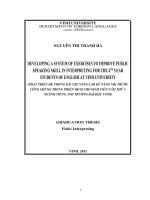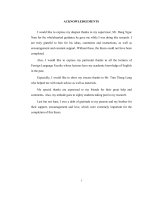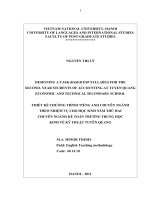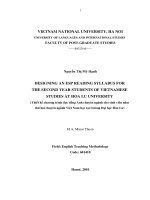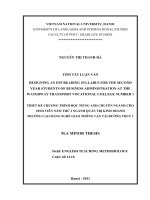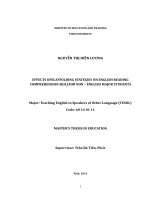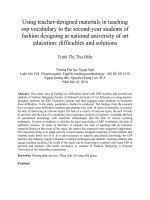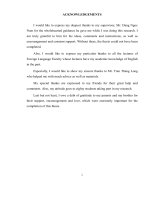Difficul ties the reading comprehension skill for the second year students of batf at hpu no 2 and suggested solutions
Bạn đang xem bản rút gọn của tài liệu. Xem và tải ngay bản đầy đủ của tài liệu tại đây (667.24 KB, 62 trang )
ACKNOWLEDGEMENTS
I would like to express my deepest thanks to my supervisor, Mr. Dang Ngoc
Nam for the wholehearted guidance he gave me while I was doing this research. I
am truly grateful to him for his ideas, comments and instructions, as well as
encouragement and constant support. Without these, the thesis could not have been
completed.
Also, I would like to express my particular thanks to all the lectures of
Foreign Language Faculty whose lectures have my academic knowledge of English
in the past.
Especially, I would like to show my sincere thanks to Mr. Tran Thang Long
who helped me with much advice as well as materials.
My special thanks are expressed to my friends for their great help and
comments. Also, my attitude goes to eighty students taking part in my research.
Last but not least, I owe a debt of gratitude to my parents and my brother for
their support, encouragement and love, which were extremely important for the
completion of this thesis.
i
ABSTRACT
The reading comprehension skill is an interesting aspect of English. In order
to address this issue, many authors have documented different management
methods to improve the reading comprehension skill. However, the reading
comprehension skill reffered to in some books have not been deal with in full and
sometimes cause confusion to learners of English.
As a result, students of English especially non-English major students often
have difficulties in reading comprehension skill. Therefore, a research with the
eighty second-year students of BATF at HPU N 2 was carried out. The data was
collected using questionnaires and classroom observation. This research work
entails studying the reading comprehension skill and conducting a survey for
difficulties analysis.
Based on the results of the survey, the types of difficulties and causes have
been found, and solutions to the problems have been suggested.
ii
LIST OF ABBREVIATIONS
HPU N 2: Hanoi Pedagogical University N
BATF: Biology and Agricultural Technology Faculty
FLF: Foreign Language Faculty
iii
STATEMENT OF AUTHORSHIP
Title:
DIFFICULTIES IN THE READING COMPREHENSION SKILL FOR THE
SECOND-YEAR STUDENTS OF BATF AT HPU N 2 AND SUGGESTED
SOLUTIONS
(Graduation paper submitted in particular fulfillment of the Degree of
Bachelor of Arts in English)
I certify that no part of the above report has been copied from any other
person’s work without acknowledgements and that the report is originally written
by me under instructions of my supervisor.
Date submitted: May 2013
Student
Supervisor
Pham Hong Loan
Dang Ngoc Nam
iv
TABLE OF CONTENTS
Acknowledgements ........................................................................................ ii
Abstract .......................................................................................................... iii
List of abbreviations ...................................................................................... iv
Statement of authorship ................................................................................ v
Table of contents ........................................................................................... vi
PART ONE
INTRODUCTION
I. Rationale .................................................................................................... 1
II. Research presupposition .......................................................................... 2
III. Research objectives.................................................................................. 2
IV. Research scope ........................................................................................ 3
V. Research tasks .......................................................................................... 3
VI. Research methods ................................................................................... 3
VII. Significance of the proposed research .................................................. 3
VIII. Design of the research work ................................................................ 4
PART TWO
DEVELOPMENT
CHAPTER ONE: THEORETICAL BACKGROUND
I.1. Literature review in brief ........................................................................ 5
I.2. Reading comprehension skill................................................................... 6
I.2.1. Definition of reading comprehension skill ........................................... 6
v
I.2.2. Types of reading comprehension skill .................................................. 7
I.2.2.1. Skimming ....................................................................................... 7
I.2.2.2. Scanning.......................................................................................... 7
I.2.2.3. Intensive reading ............................................................................. 8
I.2.2.4. Extensive reading ............................................................................ 9
I.2.2.5. Reading aloud ................................................................................. 9
I.2.2.6. Silent reading ................................................................................. 10
I.2.2.7. Recognizing ................................................................................... 10
I.2.2.7.1. Recognizing definitions and examples ....................................... 11
I.2.2.7.2. Recognizing enumerations ......................................................... 11
I.2.2.7.3. Recognizing headings and subheadings ..................................... 11
I.2.2.7.4. Recognizing signal words .......................................................... 12
I.2.2.7.5. Recognizing main ideas in paragraphs and short selections ........ 13
I.2.2.8. Understanding ..................................................................................... 14
I.2.2.9. Outlining ........................................................................................ 15
I.2.2.10. Summarizing ................................................................................ 17
I.2.3. Processes of reading comprehension skill............................................. 17
I. 2.3.1. Bottom-up process ........................................................................ 17
I.2.3.2. Top-down process .......................................................................... 18
I.2.3.3. Interactive process .......................................................................... 18
I.2.4. Strategies of reading comprehension skill ........................................... 19
I.2.4.1. Definition of reading comprehension strategy ................................ 19
I.2.4.2. Types of reading comprehension strategy ....................................... 20
I.2.4.2.1 Metacognitive strategy .............................................................. 20
I.2.4.2.2 Cognitive strategy ..................................................................... 20
I.2.4.3. Elements to build and improve reading comprehension skill .......... 23
I.2.4.3.1. Vocabulary ................................................................................ 23
I.2.4.3.2. Patterns of organization ............................................................. 25
I.2.4.3.3. Transitions ................................................................................. 27
I.2.4.3.4. Main ideas ................................................................................. 28
vi
I.2.4.3.5. Inferences ................................................................................... 29
CHAPTER TWO: THE METHODOLOGY
II.1. Questionnaire survey (Appendix A) ...................................................... 30
II.1.1. Rationale of the use of questionnaire survey ..................................... 30
II.1.2. Population of the survey ................................................................... 31
II.1.3. Construction of the survey ................................................................ 31
II.1.4. Administration of the try-out ............................................................. 31
II.1.4.1. Preparation of the try-out ............................................................ 31
II.1.4.2. Try-out ........................................................................................ 31
II.1.5. Methods of data analysis ................................................................... 32
II.2. Classroom observation .......................................................................... 32
II.2.1. Rationale of the use of classroom observation ................................... 32
II.2.2. Observation sheet (Appendix B) ....................................................... 33
CHAPTER THREE: THE RESULTS
III. 1. Results of the survey ........................................................................... 34
III.1.1. Difficulties of the second-year students of BATF at HPU N 2 in their
reading comprehension skill ............................................................................ 35
III.1.2. Expectations of the second-year students of BATF at HPU N
in their
reading comprehension skill ............................................................................ 36
III.1.3. Reasons for the difficulties of the the second-year students of BATF at
HPU N 2 in their reading comprehension skill .............................................. 37
III.1.3.1. Difficulties in unfamiliar vocabulary ........................................... 37
III.1.3.2. Difficulties in the lack of background knowledge ........................ 37
III.1.3.3. Difficulties in grammatical structures .......................................... 38
III.1.3.4. Difficulties in making accurate inferences ................................... 38
III.1.3.5. Difficulties in unfamiliar topic ..................................................... 38
III.1.3.6. Difficulties in finding the main ideas and supporting ideas .......... 39
vii
III.2. Suggested solutions ............................................................................. 39
PART THREE
CONCLUSION
Conclusion ..................................................................................................... 42
References ...................................................................................................... 45
Appendix A: Questionnaire survey .............................................................. 47
Appendix B: Observation sheet and checklist ............................................. 51
viii
PART ONE
INTRODUCTION
I. RATIONALE
It cannot be denied that English is very important since English is the most
common language spoken everywhere. We need to know English language in
order to not only communicate effectively among people from different countries
but also study any science subject. As a result, English has become an international
language.
Nowadays, in Vietnam as well as other countries, English is taught as an
obligatory subject at every educational level from primary school, secondary
school, high school to college and university. In fact, English is a compulsory
subject at all universities, especially involving in HPU N 2 where I have been
studying. However, learning English is not easy to both English major students and
non-English major students in my university. It may bring problems, especially
non-English major students. In fact, there are many non-English major students
having problems on understanding English text. It is difficult for them how to read
the text, how to identify key words, how to find important information, how to
understand the text correctly in order to do the tasks. This proves that the reading
comprehension in learning English is complex and often causes embarrassment to
them. They do not master definition, types and processes of the reading
comprehension skill like skimming, scanning, reading aloud or silent reading and
so on. In addition, strategies to build the reading comprehension skill including
vocabulary, patterns of organization, transitions, inferences and main ideas are not
improved. Due to not master the reading comprehension skill and no ways to
improve reading comprehension skill, there are many difficulties to non-English
major students.
As a prospective teacher, I would like to make a contribution to the English
teaching in Vietnam. For the reasons above, this study is conducted, which focuses
ix
on difficulties as well as solutions in the reading comprehension skill among the
second-year students of BATF at HPU N 2 in the academic year of 2012-2013.
II. RESEARCH PRESUPPOSITION
Reading comprehension is one of the most significant skills of the secondyear students of BATF at HPU N
2. During the research, some questions are
raised:
1. What are difficulties in the reading comprehension skill that the secondyear students of BATF at HPU N 2 in the academic of 2012-2013 often have?
2. What are expectations of the second-year students of BATF at HPU N 2
in their reading comprehension skill in the academic of 2012-2013?
3. What are the causes of difficulties in reading comprehension skill that the
second-year students of BATF at HPU N 2 in the academic of 2012-2013 often
have?
4. What are effective ways to help the second-year students of BATF at HPU
N
in the academic of 2012-2013 overcome difficulties in the reading
comprehension skill?
Based on the questions above, I am eager to find out the problems and make
an analysis so that the major difficulties in reading comprehension skill may be
found.
III. RESEARCH OBJECTIVES
The research focuses on the reading comprehension skill of the second-year
students of BATF at HPU 2. The study is aimed at the following goals:
1. To find out the common difficulties in reading comprehension skill that the
second-year students of BATF at HPU N 2 in the academic year of 2012-2013
often have.
2. To find out the common expectations of the second-year students of BATF
at HPU N 2 in the academic year of 2012-2013.
x
3. To find out the causes of those difficulties in reading comprehension skill
that the second-year students of BATF at HPU N 2 in the academic year of 20122013 have.
4. To find out the most effective ways to overcome the difficulties through the
survey. The solutions might be concentrated on both theory and practice, in which
some elements or techniques are also introduced with the goal of minimizing
students’ difficulties at HPU N 2.
IV. RESEARCH SCOPE
The research is limited about reading comprehension skill of the second-year
students of BATF at HPU N 2 in the academic year of 2012-2013. The reading
comprehension skill is carried out at the classroom.
The population involved in the study is eighty students of BATF at HPU N 2
in the academic year of 2012-2013.
V. RESEARCH TASKS
The study involves fulfilling the following tasks:
1. To overview the reading comprehension skill such as the definition,
classification and processes.
2. To study the strategies of improving the reading comprehension skill.
3. To conduct a survey to find out expectations, difficulties and causes. On the
basis of the findings, possible solutions to the problems are found to minimize the
students’ difficulties.
VI. RESEARCH METHODS
To achieve the objectives of the study, the following methods have been
applied:
1. Observing some reading comprehension lessons at class.
2. Collecting documents from books listed in the references.
3. Consulting the supervisor, experienced teachers and friends.
4. Conducting a survey and analyzing the results.
VII. SIGNIFICANCE OF THE PROPOSED RESEARCH
xi
After the research, it is hoped that the results will be helpful to provide:
1. Input for learners of English in order to minimize their difficulties in the
reading comprehension skill.
2. Input for teachers of English with information on expectations, difficulties
and solutions to the problems so that they can choose good methods of teaching the
reading comprehension skill.
The study is also beneficial to anyone who is interested in the reading
comprehension skill.
VIII. DESIGN OF THE RESEARCH WORK
The research work has three main parts, namely: Introduction, Development,
and Conclusion. The “Development” consists of three chapters. Chapter one is
entitled “Theoretical Background”. It consists of two sections. Section one reviews
literature review in brief. Section two deals with things related to overview of
reading comprehension skill such as definition, types, processes, strategies.
The chapter two is named “The Methodology”. It describes the research
method. It is composed of the description of the subjects and the data collection
instruments. Detail information about the research procedures is also provided.
Chapter three is named “The Results”. It has two sections. Section one is
devoted to the survey. The other presents solutions to the problems on the reading
comprehension skill.
PART TWO
xii
DEVELOPMENT
CHAPTER ONE
THEORETICAL BACKGROUND
I.1. LITERATURE REVIEW IN BRIEF
Reading comprehension skill is one of the most important parts of
English. Therefore, reading comprehension skill has been researched by many
authors like John Langan (2002), Grellet (1981), Nuttall (1982), Patricia Glenn
(1995), Doff (1988), Cambourne (1979), Nell K. Duke (2003) and so on. They
each have their own way to describe the reading comprehension skill.
John Langan (2002) in the book Reading and Study Skills deals with some
types of reading comprehension skill to help students know how to recognize
definitions and examples, enumerations, headings and subheadings, main
ideas in paragraphs and short selections; know how to outline, summarize
and understand graphs and tables.
Grellet, F (1981) in the book Developing reading skills gives definition of
reading comprehension skill and also deals with some main types of reading
comprehension skill including scanning, skimming, intensive reading and
extensive reading. In addition, the book helps students know some ways to
develop reading comprehension skill.
In the book Teaching reading skills in a foreign language, Nuttall (1982)
also focuses on definition and some types of the reading comprehension skill
consisting of intensive reading, extensive reading and reading aloud and so
on. Besides, Nuttall (1982) mentions the processes of the reading
comprehension skill such as bottom-up process, top-down process and
interactive process.
Cambourne, B (1979) in the book “How important is theory to the reading
teacher?” also shows that there are three processes of the reading
xiii
comprehension skill combining bottom-up, top-down and interactive process.
Moreover, the author provides theories to the reading teacher.
Doff, A (1988) in the book Teaching: A Training Course for Teachers
focuses on types of reading comprehension, especially reading aloud.
Nell K. Duke (2003) in the book Comprehension Difficulties decribes the
number of detailed difficulties that learners have in the reading
comprehension
skill,
main
causes
and
solutions
for
the
reading
comprehension skill.
To sum up, much research has been done on the reading comprehension
skill but only Nell K. Duke (2003) points out difficulties on the reading
comprehension skill. In fact, there are far more difficulties that learners of
English often make. Therefore, it is essential to have a really full study of
difficulties in the reading comprehension skill.
I.2. READING COMPREHENSION SKILL
I.2.1. Definition of the reading comprehension skill
According to Wikipedia, a reading comprehension skill is defined as the level
of understanding of a text or a message. This understanding comes from the
interaction between the words that are written and how they trigger knowledge
outside the text or the message.
Limor Cohen Naftali – The IACC, Department of Learning in the book
Reading Comprehension Workshop shows that the reading comprehension skill is
understanding a written text by extracting the required information from it as
efficiently as possible.
According to Johnson (1998) in the material Teaching Comprehension Skills,
reading comprehension skill is the act of constructing meaning with text. The
reader plays an active role – filtering, organizing, interpreting and generating
relationships with incoming information. Reading comprehension is an interaction
between word identification, knowledge and comprehension skills.
xiv
Karlin and Kartin (1982, p.2) in the book Teaching of Elementary Reading
states that reading without comprehension is meaningless.
I.2.2. Types of the reading comprehension skill
I.2.2.1. Skimming
Skimming is a very useful reading skill for students to locate a specific item
of information that they need. Grellet (1981, p.19) in the book Developing Reading
Skills stated: “When skimming, we go through the reading material quickly in
order to get its main points out the intension of the writer, but not to find the
answer to specific questions.”. Because of its nature, the key to skim is to know
where to find the main idea of paragraphs and to be able to synthesize them by way
of generalization.
Nuttall (1982, p.36) in the book Teaching Reading Skills in a Foreign
Language says “by skimming, we mean glancing rapidly through the text to
determine whether a research paper is relevant to our own work or in order to
keep ourselves superficially informed about materials that are not of great
importance to us.” When skimming, students should go through the reading
material quickly in order to get the gift of it, to know how it is organized, or to get
an idea of the tone or the intension of the writer.
According to Mickulecky and Jeffries (1992, p.8), skimming is high-speed
reading that can save time and help the readers get through lots of material quickly.
By skimming, the readers can get general sense of passage or book, not specific
details. The goal in skimming is not to read the text throughly, but it is used to find
out the kind information that the readers seek, and if it does determine what to read
more closely. Thus, in skimming the text, a reader needs to practice in order to
learn the key words and phrases which can cover all the materials.
I.2.2.2. Scanning
Scanning is another useful skill to locate a specific item of information that
students need. Williams (1986, p.100) in the book Reading in the language
classroom says: “scanning occurs when a reader goes through a text very quickly
xv
in order to find a particular point of information”. In contrast with skimming,
scanning is far more limited since it only means retrieving need information. This
kind of reading is widely used in the reading comprehension skill.
Grallet (1981, p.19) in the book Developing Reading Skills states: “when
scanning, we only try to locate specific information and often we do not even
follow the linearity of the passage to do so”. Scanning occurs when a reader goes
through the text quickly searching for a specific piece of information or seeing if
the text is suitable for a specific reading purpose.
Brown (2000, p.308) states that scanning is quickly searching for some
particular piece or pieces of information in a text. Scanning is quickly reading to
find the specific information. By scanning, a reader means to glance rapidly
through a text either to search a specific piece of information (e.g. name, date) or
to get an initial impression of whether the text is suitable for a given purpose.
When scanning the reader lets his or her eyes wander over the text until he or she is
looking for, whether it is a place, a kind of food, a kind of verb, or specific
information. To enable the student to scan effectively, he or she should know what
kinds of information he or she needs.
I.2.2.3. Intensive reading
Intensive reading means the careful reading of shorter, more difficult foreign
language texts with the goal of complete and detailed understanding. The objective
of intensive reading is to understand not only what the text means but also how the
meaning is produced.
Nuttal (1982, p.36) in the book Teaching Reading Skills in a Foreign
Language defines: “Intensive reading involves approaching the text under the
guidance of a teacher or a task which forces the student to focus on the text”.
Grellet (1981, p.4) in the book Developing Reading Skills states: “Intensive
reading means reading short text to extract specific information. This is an
accuracy activity involving reading for details”.
To this kind of reading comprehension, readers are required a profound and
detailed understanding of the text. They have to know every idea, every piece of
xvi
hidden information in the text. They also have to pay attention to the area of the
words in the passage through which some hints may be conveyed. In short,
intensive reading is reading in detail for a complete understanding of every part of
the text.
I.2.2.4. Extensive reading
Extensive reading means to read widely and in quantity. According to Grellet
(1981, p.4) in the book Developing Reading Skills, extensive reading means
“reading longer texts usually for one’s own pleasure. This is a fluency activity,
mainly involving global understanding”.
Harmer (1989, p.497) in the book The Practice of English language teaching
also has the same view. He states: “extensive reading would normally start with
reading for the main idea or for general comprehension and finally, after much
practice, for detailed comprehension”.
The purpose of extensive reading is to train students to read directly and
fluently in a foreign language for their own enjoyment, without the aid of the
teacher to achieve a general sense of the text, skimming for the gist and scanning
for the some key details. Extensive reading is a relatively rapid and efficient
process of reading a text for global or general meaning. In fact, most of extensive
reading is done silently and out of the classroom and it gives the students
opportunities to use their target language knowledge for their own purpose.
I.2.2.5. Reading aloud
According to Doff (1988, p.70) in the book Teaching English: a training
course for teachers states that reading aloud involves looking at the text,
understanding it and also saying it. Though reading aloud is considered a way to
convey necessary information to the others, it is unpopular activity outside
classroom. For the teacher, reading aloud is more of a speaking exercise of
pronunciation. Nuttal (1996) in the book Teaching Reading Skills in a Foreign
Language sees reading aloud as an important aid for beginners to improve their
pronunciation. However, Greenwood (1985) in the book The Teaching of English
as an International Language criticizes this idea. He fears that students may be
xvii
unable to focus adequately on the text’s meaning when they concentrate too hard
on pronouncing the words.
As for Doff (1988, p.58) in the book Teaching English: a training course for
teachers mentions, reading aloud is not very useful technique for some reasons
below:
- Only one student is active at a time, the others are either not listening at all
or listening to a bad model.
- Students’ attention is focus on pronunciation, not on understanding the text.
- It is an unnatural activity, most readers do not read aloud in real life.
- Because students usually read slowly, it takes up a lot of time in class.
By whispering the words while reading, reading aloud slows the readers down
and forces them to read every word so it can distract them from understanding the
text.
I.2.2.6. Silent reading
Lewis (1985, p.110) in the book Practical Techniques for Language Teaching
states that silent reading is the method we normally use with our native language,
and on the whole the quickest and most efficient. Unlike reading aloud, silent
reading is often used in both real life and classroom.
With silent reading, readers can best understand the reading material in the
shortest possible time because they do not need to read all the words in the text,
they can read at their own speed and if readers do not understand what they are
reading, they can read again or slow down for intensive reading. For the teachers,
silent reading is helpful for controlling the class. In silent reading, students are in
fact concentrating on the text, obtaining the meaning and extracting what they
need.
In short, silent reading is the most useful and practical way to develop the
students’ reading ability. However, it is more beneficial when the teacher
sometimes combines it with reading aloud to improve students’ pronunciation and
intonation because reading also has its own advantages.
I.2.2.7. Recognizing
xviii
John Langan (2002) in the book Reading and Study Skills has list of
recognizing
skill:
Recognizing
definitions
and
examples;
Recognizing
enumerations; Recognizing headings and subheadings; Recognizing signal words;
Recognizing main ideas in paragraphs and short selections.
I.2.2.7.1. Recognizing definitions and examples
Definitions are often among the most important ideas in a selection. They are
particularly significant on introductory courses, when much of your time is spent
mastering the specialized vocabulary of the subject. You are, in a sense, learning
the “language” of sociology or biology or whatever the subject might be. Most
definitions are abstract, and so they are usually followed by one or more examples
that help clarify their meaning.
I.2.2.7.2. Recognizing enumerations
Enumerations are keys to important ideas. Enumerations are lists of items that
may actually be numbered in a text. More often, however, a list of items is signaled
by such words as first of all, second, moreover, next, also, finally, and others.
Typical phrases that introduce enumerations are: “There are three reasons why...”;
“The two causes of...”; “Five characteristics of...”; “There are several ways to...”;
and so on.
I.2.2.7.3. Recognizing headings and subheadings
Headings and subheadings are important visual aids that give readers a quick
idea of how the information in a chapter is organized. The model below shows a
typical use of heads in a selection.
CHAPTER TITLE
The chapter title is set off in largest print in the chapter. The title represents the
shortest possible summary of what the entire chapter is about.
THIS IS A MAIN HEADING
Appearing under the chapter title are a series of main headings. Main heads may
be centered or may start at the left margin; they are often set off with capital letters
and, sometimes, a different color of ink. They represent a breakdown of the main
xix
topics covered in the chapter.
This is a subheading
Set off under the main headings are subheadings. They are in smaller type;
sometimes they are underlined, italicized, or set in from the left margin. The
subheadings represent a breakdown of the different ideas that are explained under
the main heading.
I.2.2.7.4. Recognizing signal words
Signal words help readers follow the direction of a writer’s thought. They are
like signposts on the road that guide the traveler. Common signal words show
emphasis, addition, comparison or contrast, illustration, and cause and effect.
+ Emphasis words: Among the most valuable signals for readers to know are
emphasis words, through which the writer tells readers directly that a particular
idea or detail is especially important. Look over the following list of emphasis
words.
important to note
especially valuable
the chief factor
most of all
most noteworthy
a vital force
a significant factor
remember that
above all
+ Addition words: Addition words tell readers that the writer’s thought is
going to continue in the same direction. The writer is going to add on more points
or details of the same kind. Look over the following addition words.
also
first of all
last of all
and
another
for one thing
next
second
finally
furthermore
moreover
the third reason
+ Comparision or contrast words:
- Comparision words signal that the author is pointing out a similarity
between two subjects. They tell readers that the second idea is like the first one in
some way. Look over the following comparision words.
xx
like
just as
in the same way
similarly
likewise
alike
in like manner
equal
- Contrast words signal a change in the direction of the writer’s thought.
They tell readers that the author is pointing out a difference between two subjects
or statements. Look over the following contrast words.
but
however
yet
differ
variation
on the other hand
still
conversely
in contrast difference on the contrary
otherwise
+ Illustration words: Illustration words tell readers that an example or
illustration will be given to make an idea clear. Look over the following illustration
words.
for example
specifically
for instance
to illustrate
once
such as
+ Cause-and-effect words: Cause-and-effect words signal that the author is
going to describe results or effects. Look over the following cause-and-effect
words.
because
reason
since
therefore
effect
as a result
so that
thus
consequently
I.2.2.7.5. Recognizing main ideas in paragraphs and short selections
Almost every effective communication of ideas consists of two basic parts:
(1) a point is made, and (2) evidence is provided to support that point. The purpose
of textbooks is to communicate ideas, and they typically do so by using the same
basic structure: A point is advanced and then supported with specific reasons,
details, and facts. Readers will become a better reader by learning to look for and
take advantage of this basic structure used in textbooks.
Many textbook paragraphs that readers read will be made up of the same two
basic parts. The point is usually expressed in one sentence called a main-idea, or
topic-sentence. The other sentences in the paragraph contain specific details that
xxi
support or develop the main-idea sentence. Learning how to recognizing these two
basic parts quickly is sure to increase reading comprehension.
I.2.2.8. Understanding
Munby (1978) in the book Communicative Syllabus Design has list of
understanding skill: Understanding explicitly stated information; Understanding
information when not explicitly stated; Understanding conceptual meaning,
Understanding the communicative value (function) of sentences and utterances;
Understanding relations within the sentence; Understanding relations between the
parts of a text through lexical cohesion devices; Understanding relations between
the parts of a text through grammatical cohesion devices.
John Langan (2002, p.439) in the book Reading and Study Skills focuses on
understanding graphs and tables. Sometimes, being a skillful reader means more
than just having the ability to read words. It can also mean being able to read the
visual information presented in graphs and tables. As a student, reader will
probably encounter many graphs and tables in textbooks. Such visual material can
help students understand important ideas and details. Knowing graphics will
probably also help in a career work as well, for occupations in a computerized age
increasingly rely on graphics to convey information. Graphs and tables present
information by using lines, images, or numbers as well as words. They often
compare quantities or show how things change over a period of time. Reading a
graph or table involves four steps.
- Step 1: Read the title and any subtitles. This important first step gives
readers a concise summary of all the information in the graph or table.
- Step 2: Read any information at the top. At the bottom, and along the sides.
Such information may include an explanatory key to the material presented. It may
also include a series of years, percentages, or figures.
- Step 3: Ask yourself the purpose of the graph or table. Usually, the title can
be turned into a question beginning with What, How much or many, or How. The
purpose of the graph or table is to answer that question.
xxii
- Step 4: Read the graph or table. When reading, keep in mind the purpose of
the material.
I.2.2.9. Outlining
John Langan (2002, p.409) in the book Reading and Study Skills says that
outlining is another reading comprehension skill that will improve students’
reading comprehension as well as provide additional benefits. Outlining is an
organizational skill that develops their ability to think clearly and logically. It will
help as students prepare textbook and classroom notes. It will also help as they
plan speeches that they have to give or papers that you have to write. Students have
already learned a good deal about outlining in marking enumerations, noting
relationships between heads and subheads, and identifying main idea in
paragraphs. In an outline, students reduce the material in a selection to its main and
supporting points and details. Special symbols are used to show how the points and
details relate to one another. There are four points to note about outlining:
- First: The purpose of an outline is both to summarize material and to show
the relationships between different parts of the material. An outline is a summary
in which letters and numbers are used to mark the main and supporting points and
details. In an outlining, a sequence of symbols is used for the different levels of
notes. For example, capital letters (A, B, …) are used for the first level, numbers
(1, 2, 3, ...) for the second level, and small letters (a, b, c, ...) for the third level.
- Second: Put all the headings at each particular level at the same point in
relation to the margin. For example, A and B are both at the margin; 1, 2, and 3 are
all intended an equal amount of space from the margin; and a, b, and c are all an
equal, greater amount of space from the margin as follows:
- Third: Most outlines do not need more than two or three level of symbols. In
textbook note-taking, two levels will often do.
- Fourth: Every outline should have a title that summarizes the information in
the outline.
xxiii
There are some diagrams (also known maps or clusters) that many students
use for outlining. In diagramming, students create a visual outline of shapes as well
as words. Diagrams usually use circles or boxes that enclose major ideas and
supporting details. The shapes are connected with lines to show the connections
between ideas. Notice that in the balloon diagram, the main idea is written in the
large circle that anchors the entire outline. Each supporting idea occupies one of
the ballons attached to the main idea. In the box diagram, the main idea is written
in the long box at the top.
Balloon Diagram has the shape as follows:
2.Sup
idea 2
1.Sup
idea 1
3.Sup
idea 1
2.Sup
idea 2
1.Sup
idea 1
3.Sup
idea 3
A.Main idea 1
B.Main idea 2
4.Sup
idea 4
Title
Box Diagram has the shape as follows:
Title
A. Main point 1
B. Main point 2
1. Supporting idea 1
1. Supporting idea 1
2. Supporting idea 2
2. Supporting idea 2
3. Supporting idea 3
xxiv
3. Supporting idea 3
4. Supporting idea 4
I.2.2.10. Summarizing
According to John Langan (2002, p.424 – 425) in the book Reading and Study
Skills, a summary, like an outline, is a reduction of a large quantity of information
to the most important points. Unlike an outline, however, a summary does not use
symbols such as A, 1, a, and so on, to indicate the relationships among parts of the
original material. The preceding summary includes the most important points – the
definition of rationalization and an example that makes the definition clear – but
the other material is omitted.
Summarizing is helpful because it requires that readers thoroughly understand
the material they are reading. They must “get inside” the material and realize fully
what is being said before they can reduce it to a few words. Work in summarizing
material will help build their comprehension power. It will also markedly improve
your ability to take effective classroom and textbook notes.
The length of a summary depends on readers’ purpose in summarizing. The
shortest possible summary is a title. If their purpose requires more information than
that, a one-sentence summary might be enough. Longer passages and different
purpose might require longer summaries. For example, in writing a report on an
article or book, students might often want to have a summary that is a paragraph or
more in length.
I.2.3. Processes of reading comprehension skill
I.2.3.1. Bottom-up process
According to Cambourne (1979) in the book “How important is theory to the
reading teacher?”, the bottom-up process is the basis of a large number of reading
comprehension schemes.
xxv
